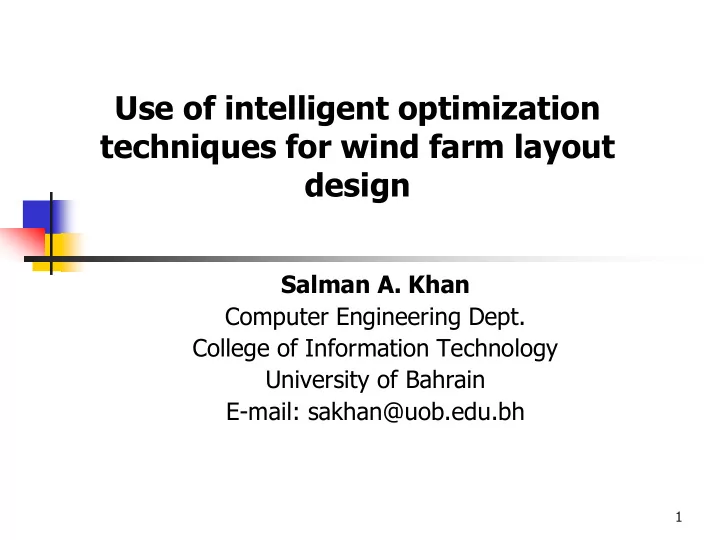

Use of intelligent optimization techniques for wind farm layout design Salman A. Khan Computer Engineering Dept. College of Information Technology University of Bahrain E-mail: sakhan@uob.edu.bh 1
Outline Wind Farm Layout Design Problem Intelligent optimization techniques Observations and Research Opportunities Conclusion 2
Wind Farm Layout Design Problem Wind energy has emerged as strong alternative to fossil fuels for power generation. This energy is harnessed from on-shore or off-shore wind farms 3
Current Status 600 Installed capacity, (GW) 487 500 433 400 370 318 283 300 238 194 200 158 94 121 74 100 59 48 39 31 24 17 0 Year 4
Current Status (contd.) China leads the global market with new addition of 23,328 MW generation capacities to the grid in 2016. Followed by United States, Germany, India, and Brazil which added 8,203, 5,443, 3,612 and 2,014 MW in 2016 France, Turkey, Netherlands, United Kingdom and Canada took 6 th to 10 th places with new wind power capacity additions of 1,561, 1,387, 887, 736, and 702 MW respectively Africa and Middle East with small contribution. 5
Wind Farm Layout Design Problem “Optimal” placement of these wind turbines in a wind farm is complex optimization problem There are a huge number of possible configurations of arranging these turbines The aim is the find the best one out of these How simple is it? 6
Wind Farm Layout Design Problem Schematic of a Wake model 7
Wind Farm Layout Design Problem Direction of Wind Wind Farm Grid of 10 X 10 8
Wind Farm Layout Design Problem Two configurations with 19 turbines Two configurations with 15 turbines 9
How complex is the problem? Up to 2 100 possible configurations Need to Maximize power output Minimize cost Both Trying all possible configurations (exhaustive search) and finding the best configuration is computationally expensive Search intelligently ! 10
Intelligent optimization techniques Artificial Intelligence techniques to solve complex optimization problems. Intelligently search for a limited number of solutions, rather than all solutions Still able to find the best (optimal) solution in many cases Otherwise, give solutions which are very close to optimal solutions 11
Various Intelligent optimization techniques Genetic algorithm – based on the theory of reproduction Particle swarm optimization – how birds search for food source Simulated Annealing – based on phenomenon of metal cooling Ant colony optimization – based on how ants search for food source Honey bee colony optimization – how honey bees search for food Cuckoo search – based on behavior of cuckoos 12
Observations and Research Opportunities Research publications from 1992 to 2016 were analyzed Genetic algorithm was used in more than 70 % publications. Researchers need to focus on other recent algorithms Most applications only considered either cost or power in the optimization process Single-objective optimization More realistic approach is multi-objective optimization No standard test suites available for comparative studies Researchers need to focus on development of benchmark test cases 13
Observations and Research Opportunities Basic versions of algorithms were used Need to develop better and more efficient algorithms Hybridization of algorithms Dynamic assignments of parameters Hyperheuristics Parallelization Lack of comparative studies Multiple algorithms should be applied and compare to a given problem 14
Conclusions Wind energy has a lot of potential for clean energy worldwide. Optimal layout design of a wind farm can maximize its performance, both in terms of power generation and financial savings. Due to high computational complexity involved in the process, Intelligent algorithms play a key role in determining the best layout in reasonable computational time 15
Thank you 16
Recommend
More recommend